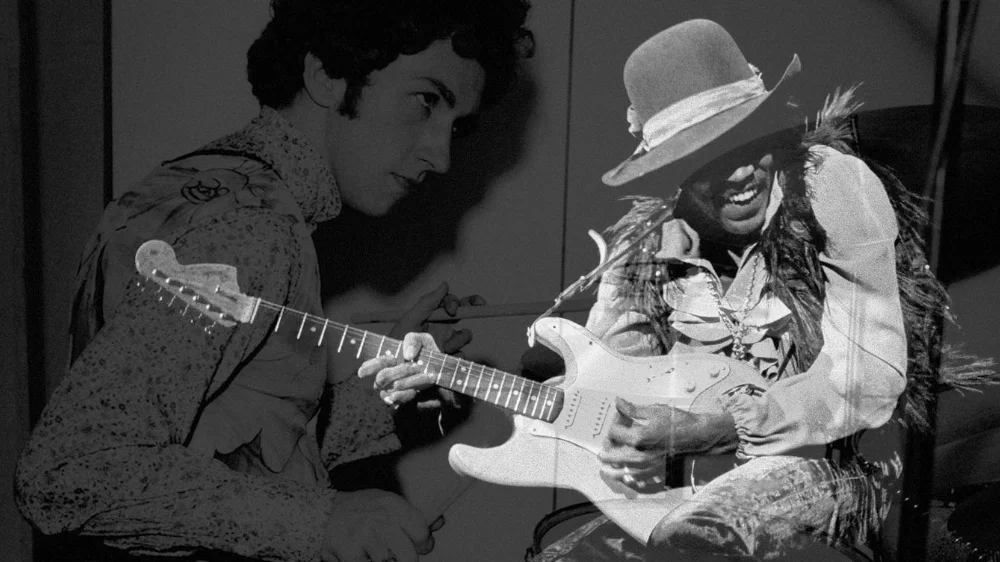
Jimi Hendrix steals the show, but it’s the wizard behind the drum kit who has drawn my attention this time.
Jimi Hendrix left the USA and came to Britain in the mid-1960s, emerging on the London pop music scene, almost out of nowhere. Hendrix was inspired by African-American Blues artists notably Muddy Waters and Elmore James. During his early career as a touring musician, back in the USA, he performed with the Isley Brothers, who had a funkier, soulful approach to R&B music. Eager to showcase his talent and start his own group, Hendrix headed to London, a city that was, by the 1960s, a trendsetting location for popular interpretations of old American Blues and Jazz.
The Jimi Hendrix Experience were likely the first popular fusion band, a genre later defined as Rock (or amplified Blues), Soul/Funk with Jazz improvisation. There would be no swinging dance floor bangers without the feel and rhythm of Jazz. George Clinton and Funkadelic continued Hendrix’s work at the dawn of the 1970s, which would later influence Prince. For Hendrix to make his highly energised interpretation of the Blues really swing, he needed an exceptional, Jazz-influenced drummer. Mitch Mitchell (1946-2008), originally from Ealing in London, grabbed his chance.
While we should not overlook Buddy Miles, drummer and vocalist, who briefly sat on the Hendrix drum stool for the Band of Gypsies live album and often jammed with Hendrix, it’s Mitchell who was the mainstay time keeper for most of Hendrix’s live and recorded work, right up until his last show at the Isle of Wight festival in 1970. Mitchell’s drumming is unmistakable for its breathtaking sense of feel and swing. Considering all Hendrix’s bands played a great deal louder than acoustic Jazz bands, the exquisite detail in Mitchell’s technique around the kit is astounding at such blistering volumes.
The 2018 Hendrix release Both Sides of the Sky is a treasure trove of breathtaking Jazz-inspired beats and fills. I cannot believe that Mitch Mitchell being offered the Jimi Hendrix Experience drumming gig in 1966 was decided on the toss of a coin, but apparently so. On a drum kit, Mitchell was the equal of Hendrix. A virtuoso intimately locked into the improvised, all-bets-are-off, approach of his boss. Drummers tend to lock in with the bass player, to accentuate rhythm. However, Mitchell also shaped the music, providing inflection points for rhythm and solos.

Notable Hendrix albums featuring Mitch Mitchell playing drums: Electric Ladyland, Live in Maui and Both Sides of the Sky
Mitchell stayed with Hendrix until the end, performing on nearly all his recordings. Mitchell and his natural, syncopated style of drumming possibly inspired Hendrix to go in an even funkier direction. Mitchell is featured prominently in the 1969 Woodstock movie alongside percussion players, it’s just spellbinding to watch.
A later film entitled Rainbow Bridge, an unscripted hippy film released in 1970, also features a notable live performance of the Jimi Hendrix Experience.
The Rainbow Bridge concert took place near a volcano in Maui, Hawaii. The remainder of the movie had no script and featured mostly guys surfing, hipsters, groupies and hangers-on. The film tanked at the box office, however, the live performance by the Hendrix power trio was the project’s saving grace. Thankfully there now exists an electrifying soundtrack simply titled Live in Maui.
For me, the Maui gig features the ultimate Experience line-up, just the core trio, including Mitchell and Hendrix’s former army buddy Billy Cox playing a very funky bass.
The Maui master tapes were not in great shape, the drums inaudible, likely due to weather conditions. Microphones were covered in yellow foam to eliminate interference. A drum kit is difficult to record in open air, with so many component parts and sound flying off in every direction. Today, outdoor stage areas are partially enclosed which really helps capture a decent recording. Later, Mitchell painstakingly re-recorded all the drum parts in a studio, as he watched a visual playback of his own performance.
Given how improvised Hendrix live shows were, that’s quite a feat.
1970 is sadly the year that Hendrix died. His last show was the Isle of Wight festival in Britain, passing away shortly after in London aged 27. I’d have just celebrated my first birthday, it would be a further sixteen years before I finally heard Hendrix’s music (Are You Experienced). After Hendrix’s death Mitchell continued working with engineer Eddie Kramer on unfinished Hendrix recordings, including the overdubbed drum parts for the Rainbow Bridge/Maui concert. Mitchell had also worked with many other virtuosos including Jack Bruce and Jeff Beck. He died in 2008 aged 62.

Alongside bass players Billy Cox and Noel Redding (1945-2003), Mitchell is the musician you will likely see interviewed in documentary films on Hendrix, appearing modest and slightly eccentric. Other exceptional and notable drummers, including Stewart Copeland, cite Mitch Mitchell as a big influence on their free-form, syncopated playing style.
Mitchell has a magical, amplified Jazz feel and when listening to his performances you feel anticipation of where he might go next, especially when you sense that Hendrix will, at any given moment, fly off into a haze of feedback and note bending. A wash of cymbals evokes a smokey vibe to the music’s discordant ambience, while the snare and kick drum perform intricate offbeats and drum rolls.
The Hendrix wall of sound becomes improvised fusion played at a very high intensity.
Looking back to the days when I frequented rock clubs, in the 1980s and 90s, every Rock fan was a Hendrix fan, but you rarely heard his music played by DJs. That might be because Hendrix’s music swings, the beats are not really aggressive or regimented workouts as heard in Hard Rock/Metal. The wailing, funky guitar breaks and syncopated interludes make the music more universal, influencing a wide spectrum of later dance-orientated genres and Rock/Funk crossover bands.
Mitch Mitchell wasn’t merely providing a backbeat, but sculpting a Jazz feel around psychedelic blues guitar that inspired future generations of fusionists.